Ice fishing requires special gear for the fish and for the temperatures. The equipment you will need for ice fishing is much different than freshwater fishing. It's important to have the right gear including the right electronics, ice tools, rods, reels, ice fishing bait and lures.
Bait and Lures
Learn more about the different types of bait and lures used for ice fishing.
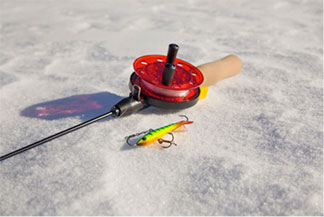
ICE FISHING BAIT & LURES
For an ice fishing rod, live or artificial bait will work. For your small lures consider jigs or flies. You can try teardrop jigs with horizontal presentation (the hook tip points horizontally in the water column while fishing) or banana jigs with a vertical presentation (the hook tip points vertically in the water column while fishing). For live bait, try wax worms (bee moth larva), or maggots, spikes (fly larvae), wigglers (mayfly larvae) or minnows. You can drop your bait and leave it alone, or you can slowly jig to attract the fish. Jigging is most successful if a lure of any kind is used. If you do not want to use live bait, try plastic lures. Plastic lures come in a variety of colors and shapes and are made to resemble a worm.
For bigger fish, a larger hook with larger live bait like minnows, smelt, salmon eggs or spawn bags is frequently used. If you plan to jig with live bait, spawn bags or salmon eggs are the best option.
Rods and Reels
Learn more about the different types rods and reels used for ice fishing.
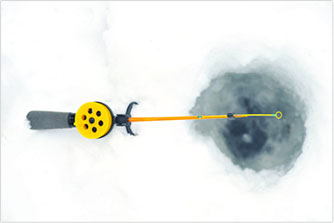
ICE FISHING RODS AND REELS
Unlike a freshwater or saltwater rod, an ice fishing rod is very short. Modern ice rods are typically a type of spinning rod varying from 24 to 36 inches in length. Spinning rods are typically made of graphite or fiberglass and can with stand the cold while still remaining flexible. Depending on what type of fish you plan to catch will help determine what sensitivity you should look for in your rod. Remember that in cold water, fish are not as active, so a bite might not elicit a large movement in your rod. For panfish you want a rod that is ultralight, but if you plan to catch game fish like Northern pike, you can consider something heavier.
A spinning reel or even a simple spring-tension spool will work for ice fishing. The line you choose for your reel should match your rod. The more lightweight the rod, the lighter the line needed.
You can also use a fly reel if you do not have a spinning reel, it is very similar. The advantage of a fly reel is that you have less line twist.
Some anglers prefer to fish with tip-ups, which is not a rod at all. A tip-up is a device set on the ice above your hole that dangles bait beneath it with a flag as a strike indicator. Tip-ups, which typically hold a small reel submerged in the water, get their name from a flag that's bent over and attached to the reel. When a fish takes the bait, the reel turns and releases the line and flag at the same time. The flag' "tips up" alerting the angler something is on the line.
Most tip ups are made of wood, but some newer versions are circular in shape to help keep your hole from freezing up. The best line for a tip-up is heavy, braided line as tip-ups are better for larger fish such as walleye.
Many anglers will bring both a spinning rod and tip-up and setup two holes at different but close by locations, giving themselves more opportunities to hook a fish. In one hole, you can slowly jig with your spinning rod, while the other hole has a tip-up.
Ice Fishing Tools
Learn more about different ice fishing tools available and how to use them.
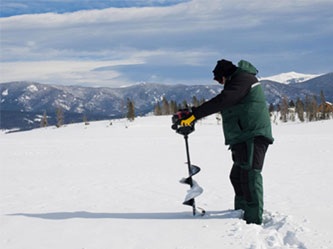
AUGERS, CHISELS AND OTHER ICE TOOLS
An auger is a drilling device that resembles a giant cork screw. It has a spiraling sharp edge that operates like a hand drill to make a hole in the ice. For extremely thick ice, power augers that run on batteries or small gasoline engines are available and make creating holes much easier.
A chisel (sometimes called a spud) is a long-handled blade that comes to a point on one side. It can be used to chip into the ice or make holes in thinner ice.
It is also good to bring a slush scoop or some sort of deep ladle. A slush scoop has holes in it and allows you to scoop excess ice and slush out of your fishing hole.
Electronic Tools for Ice Fishing
Electronics tools can be very beneficial, and can help you catch more fish.
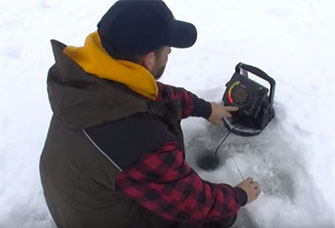
ELECTRONICS
Many anglers will opt to bring along electronic tools for locating fish. These are not a must, but can be very beneficial. A GPS is great for marking your fishing spots for future ice fishing adventures. GPS is also helpful in navigating if you have taken a snowmobile or vehicle to your fishing location.
Flashers are sonar devices that reveal objects within your water column on a circular screen. Similar to a depth finder or fish finder, flashers can help you identify if there are fish within your fishing hole location and at what depth. A flasher should also be able to pick up your line and bait if dropped simultaneously. This helps you to see if you bait is attracting any motion (fish) under the water.
To take it a bit further, some anglers will use underwater cameras, providing a live image of what is happening under water. This helps anglers better understand fish behavior.
Ice Fishing Shanties
Shanties are portable shelters that will protect you on windy days while ice fishing.
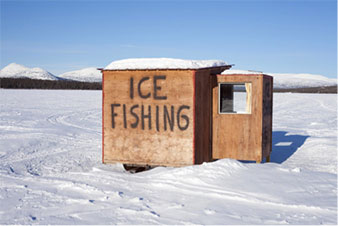
SHANTIES
Ice fishing can be a fairly cold activity, especially on those windy days when it doesn't seem fit to be outdoors. On such days, a shanty, or a portable shelter will help you with the cold. Some shanties can be directly purchased from a store and are made of portable, insulated walls. Other shanties can be home made. Many anglers make them out of plywood and other materials you can find at your local hardware store.
It's important to make sure you can pull the shanty onto the ice (if available use a snow mobile or vehicle). Also remember to check the ice thickness first to ensure that it can handle the weight of the shanty.
Many anglers will bring additional equipment for inside their shanty. Portable heaters help keep you warm and keep your fishing hole from freezing up. Buckets can be flipped over for chairs and be useful for carrying your rods, lures and baits.
In some areas of the country shanties can be elaborate creations. Some anglers will leave their shanty up for the entire winter season and will equip them with portable bathrooms, beds and more.
Clothing for Ice Fishing
These are some basic items for warmth to bring on your next ice fishing trip.
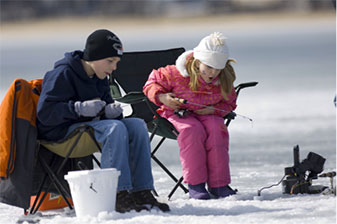
①Layered clothing. Staying warm and dry is important. Do not skip this step, even if you bring a heater. A moisture-wisking base layer, an insulated, wind-breaking middle layer, and a breathable outer shell are recommended. Changing weather conditions or a heater that quits working could end your day early if you aren't prepared.
②Insulated boots. Wearing moisture-wicking liner socks under warm socks and good boots can keep you comfortable.
③Scarf, hat and gloves. Keeping your hands and ears warm will help you keep your whole body warm. It's also good to bring an extra pair of gloves in case you get the other pair wet.
④Ice cleats. These allow you to maintain traction, even on slick ice to keep your balance.
⑤Ice safety picks. Wear safety picks (short plastic rods with medal picks) around your neck in case of an emergency. They are very useful if you fall in as you can quickly grab them to help you grip the ice.

